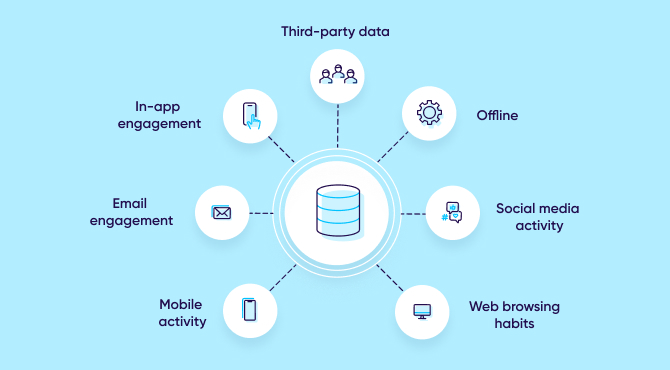
Data management platform (DMP)
A data management platform (DMP) is a centralized database used to collect, store, and deploy customer data for digital advertising purposes. DMPs compile data from multiple channels to paint a picture of a user’s demographic information, interests, and online behaviors.
What is a data management platform?
A data management platform (or DMP for short) is a tool that can form a profile about individual customers, give big-picture analytics, and facilitate personalization in marketing campaigns.
Think about it: most marketers create campaigns based on personas, or fictionalized profiles of their ideal customer. But what if you didn’t need to rely on fiction and guesswork to launch a successful app marketing campaign? What if you could automate your digital ad buys based on real-time behavior and interests?
You can use a DMP to:
- help you make the most of your data with business intelligence and automation
- gain valuable insights into your customers’ behavior and preferences, optimize your advertising spend, and comply with data privacy regulations
- enhance your tech stack by interacting with customer relationship management platforms, customer data platforms, and demand-side platforms
Why are data management platforms important to app marketers?
DMPs are critical for programmatic advertising, the automation of media buying using AI and machine learning, and play a key role in mobile user acquisition.
Think about all the different information that you gather about your audience:

Bringing all your data together makes it much more powerful — and with a DMP, you can combine first-party, second-party, and third-party data for a clearer picture. Let’s review these different types:
- First-party data is data collected directly from a source, such as a website or app, and is usually owned by the company itself.
- Second-party data was originally collected by one party, but is shared with another party through an agreement. It includes things like social media profiles and customer reviews, that are shared with you via a trusted partner.
- Third-party data is data that has been gathered from multiple sources and is aggregated and sold by a third-party organization. In programmatic advertising, this type of data can be used to target specific audiences, track user behaviors, optimize campaigns, and measure results.
Without a centralized system, app marketers are stuck pulling insights from multiple data types and sources, wasting valuable admin time, and making manual decisions about how and where to place ads.
A DMP not only centralizes data from these different sources, giving a unified view of customer behavior — it also provides management software for app marketers to activate that data into campaigns.
Development of data management platforms
The first DMP, called BlueKai, was pioneered by a tech entrepreneur named Omar Tawakol. Tawakol realized that companies had general information about their customers but were missing the golden key that is buyer intent. When a person clicks on a travel website like Expedia, for example, that event shows an intent to plan a trip.
Though it took some time for the concept to take off, DMPs are now a mainstay of the digital advertising industry. Oracle acquired BlueKai for $420 million in 2014 just six years after its founding.
DMPs have removed the guesswork and negotiation when it comes to placing ads. They facilitate programmatic advertising by segmenting audience data, identifying efficient placements, and letting marketers both buy and sell ad impressions with automated bidding.
DMP vs. CDP, DSP and DCR

Before we go any further, let’s distinguish between a DMP and a CDP, or customer data platform. A CDP aggregates customer information into a single database from multiple sources. This can include both personally identifiable information and anonymous behavioral data. However, a CDP is simply a database — it doesn’t give marketers the ability to analyze the data or take any actions. It acts as a bridge to share data with any platform that needs it, like a CRM or DMP.
A data management platform (DMP) is a SaaS platform that not only stores data, but delivers insights into customer behavior and has the ability to deploy campaigns and generate leads. DMPs are most commonly used by app marketers for segmentation, targeting, and personalization.
Two other terms you need to know are DSP and DCR.

- A demand-side platform (DSP) is a platform that enables advertisers to buy ad space from multiple publishers with real-time bidding. Advertisers can bid on impressions in an auction-style marketplace and target their ads based on user data stored in the DMP. For instance, Facebook Ads Manager is a DSP that allows you to purchase Facebook and Instagram ad inventory.

- A data clean room (DCR) is a data-sharing solution that allows two parties to merge first-party data sets in a secure and compliant way. With iOS privacy updates eroding advertisers’ first-party data, DCRs have become increasingly popular as they allow companies to build more robust data profiles for targeting while safeguarding customer privacy. DCRs are a separate but complementary platform to a DMP. Google, Facebook, and Amazon each have their own DCR services.
How does a DMP work?
At a high level, a DMP collects first-, second-, and third-party data from different channels and devices, and anonymizes it. Let’s take a closer look at the steps.

- Marketers set up their DMP and feed in initial data to set a foundation. This can include:
- Online data from mobile apps, websites, analytics, and so on
- Offline data from sources such as your CRM, purchase history, or email.
- The DMP compiles and anonymizes the data and categorizes it.
- Marketers can add tags or further categorization to the data.
- The DMP provides reporting and audience insights.
- The DMP connects with common ad networks and digital channels for data activation.
- Based on insights, marketers can set up campaigns to run based on real-time customer data.
What you can do with DMPs
Now that you know what a DMP is, the magic begins: leveraging data to boost advertising engagement.
Here are six ways a DMP can supercharge your app marketing efforts.

1. Segment your audience
Before the advent of programmatic advertising, app marketers would mostly segment audiences based on broad demographic strokes. With rich data augmented by AI, DMPs can segment audiences based on interests, behavior, needs, and more. Algorithms can even enable you to find similar audiences to the ones you build and segment.
2. Personalize your ads
Once you have audience segments, you can launch personalized ad campaigns. Take an eCommerce company, for example. Rather than running a general ad for your brand or current sale, you can run an ad for specific products that the DMP determines particular users may be interested in.
3. Retarget across devices
Since DMPs integrate data from across devices, you have the ability to launch personalized ad campaigns that leverage impressions across devices and channels. By connecting your DMP to a DSP, you can set up ad campaigns that “follow” a user from site to site or from desktop to mobile.
4. Improve your marketing ROI
Another benefit of using a DMP is that it can help you optimize your advertising spend. By analyzing data on customer behavior and preferences, a DMP can help you identify the most effective channels and messages for reaching your target audience. This can help you allocate your advertising budget more effectively and achieve better results.
5. Get audience insights
Since you’re able to track ad campaigns to purchases, you can also follow the information trail retroactively to glean insights about who’s actually buying your product or service. Advanced analytics can produce market research for you to share key demographic and behavioral attributes about your customers.
6. Stay compliant
Perhaps the most important benefit of using a DMP is that it can help businesses comply with data privacy regulations. With the General Data Protection Regulation (GDPR) and other privacy laws in place, businesses need to be careful about how they collect and share customer data. Fines for mishandling EU citizens’ data under GDPR start at €10 million or 2% of a company’s revenue. A DMP can help your business stay within the bounds of the law, avoiding costly fines and protecting your reputation.
Data management platforms and your marketing tech stack
DMPs are just one cog in the wheel that is an app marketer’s tech stack. Building a tech stack that’s right for your business is complex, as you’ll likely need to choose between vendors and find multiple platforms that will work together. The number of martech options is overwhelming — platforms have grown nearly 10x in the past decade (2012-2022), and now include marketing automation, analytics, attribution, and more.
Do I need a DMP?
Wondering if a DMP is right for you? Well, startups may not need a DMP if they don’t have a dedicated marketing team to build and run it, or may choose to have a digital marketing agency manage one. Many small startups start with free products analytics tools for basic analytics before they advance to more robust, paid product suites for scalable growth.
Medium and enterprise companies with established marketing teams should have a DMP to enable them to automate and optimize their mobile ad campaigns. Let’s look at the different types of tools that can help app marketers succeed through each of your product life cycles.
Testing
- Product analytics for app measurement
Deployment
- Attribution providers for measurement and marketing automation for advertising orchestration
Growth
- Media partners and location services for advertising orchestration
- CDP as a stack connector
Maturity
- Cloud storage and data visualization for measurement
- DMP and marketing cloud platform as stack connectors
Lay your martech foundation for user acquisition
DMPs function as a stack connector to support app growth and lead a product into maturity. In order to use a DMP effectively, you need a few foundations in place:
- A CRM platform to house your lead and customer information
- A CDP to clean and compile your data in a centralized database
- A DSP to purchase ad inventory
In addition, your team needs to set best practices for collecting, storing, and categorizing your first-party data in order to keep your data practices clean and compliant with international regulations.
Go further with data intelligence
To bring your app marketing strategy to maturity, you need to go a step further. Adding attribution is the ultimate data intelligence to let you measure results and understand which marketing channels are resulting in app downloads. Mobile attribution is the process of documenting and attributing each app install and app engagement to the marketing or media source that referred it.
Finally, you can bring your marketing efforts full-circle by measuring in-app analytics. In the free-to-install app ecosystem, installs may not translate into revenue. You still need a tool to measure retention and in-app engagement. Find a mobile measurement partner (MMP) like AppsFlyer that can measure campaign analytics across devices and platforms.
Key takeaways
- A DMP is a centralized database that compiles and categorizes first-, second-, and third-party data, as well as providing an interface for data activation.
- A DMP is distinct from a CDP, DSP and DCR, but complements each of these martech tools in a marketer’s tech ecosystem.
- DMPs are a key component of programmatic advertising: they help marketers segment their audience, find similar audiences, and deploy personalized ads through automated bidding.
- While start-ups may not need a DMP, it’s an essential component of an app marketer’s tech stack to bring a product to maturity.
- Before you start using a DMP, you need to put the foundations in place including a CRM platform, a customer data platform and a data clean room.
- With a DMP, marketers can automate their ad buying for improved ROI and continued growth, while sophisticated analytics and intelligence help measure campaign success.



